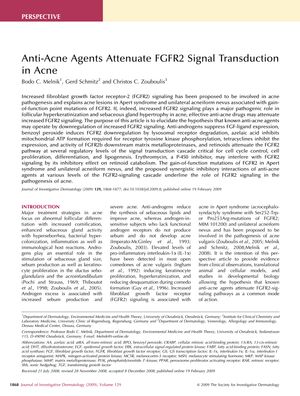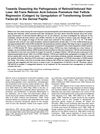Anti-Acne Agents Attenuate FGFR2 Signal Transduction in Acne

TLDR Anti-acne medications may work by reducing the activity of a protein involved in acne development.
The document from 2009 discusses the hypothesis that anti-acne agents work by reducing the signaling of fibroblast growth factor receptor-2 (FGFR2), which is believed to play a significant role in the development of acne. It suggests that increased FGFR2 signaling is involved in acne pathogenesis, particularly in conditions like Apert syndrome and unilateral acneiform nevus, which are associated with FGFR2 mutations. The article outlines how various anti-acne drugs may inhibit FGFR2 signaling: anti-androgens suppress FGF-ligand expression; benzoyl peroxide leads to FGFR2 downregulation through lysosomal receptor degradation; azelaic acid blocks mitochondrial ATP formation, which is necessary for receptor tyrosine kinase phosphorylation; tetracyclines inhibit the expression and activity of FGFR2b downstream matrix metalloproteinases; retinoids reduce FGFR2 signaling at multiple regulatory points in the signal transduction cascade that are crucial for cell cycle control, cell proliferation, differentiation, and lipogenesis; and erythromycin, as a P-450 inhibitor, may affect FGFR2 signaling by inhibiting retinoid catabolism. These mechanisms highlight the potential role of FGFR2 signaling in acne and support the therapeutic targeting of this pathway by anti-acne medications.
View this study on jidonline.org →
Cited in this study

research Towards Dissecting the Pathogenesis of Retinoid-Induced Hair Loss: All-Trans Retinoic Acid Induces Premature Hair Follicle Regression (Catagen) by Upregulation of Transforming Growth Factor-β2 in the Dermal Papilla
All-trans retinoic acid causes hair loss by increasing TGF-β2 in hair follicle cells.
research Cytochrome P450: A Target for Drug Development for Skin Diseases
Modulating Cytochrome P450 activity could help develop new skin disease treatments.
research Lipid analysis of follicular casts from cyanoacrylate strips as a new method for studying therapeutic effects of antiacne agents
research The Human Sebocyte Culture Model Provides New Insights into Development and Management of Seborrhoea and Acne
The human sebocyte culture model has improved understanding of oily skin and acne, and how they can be treated.